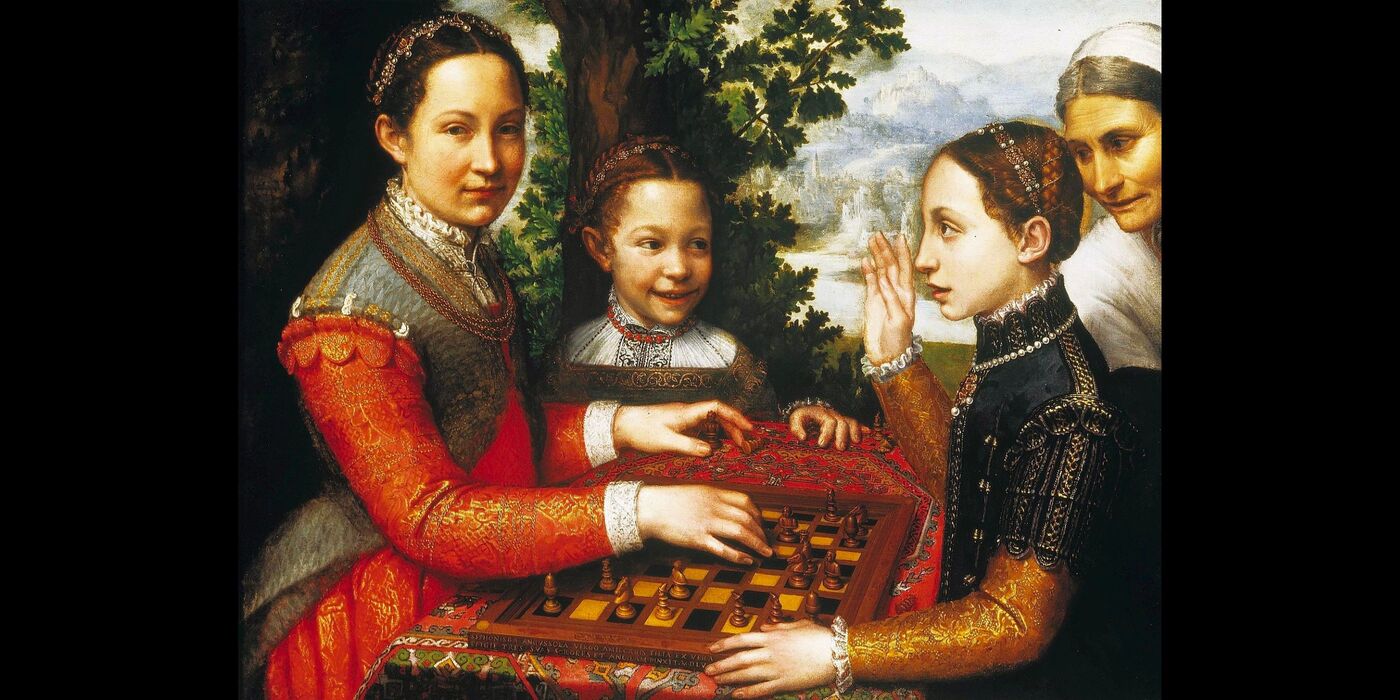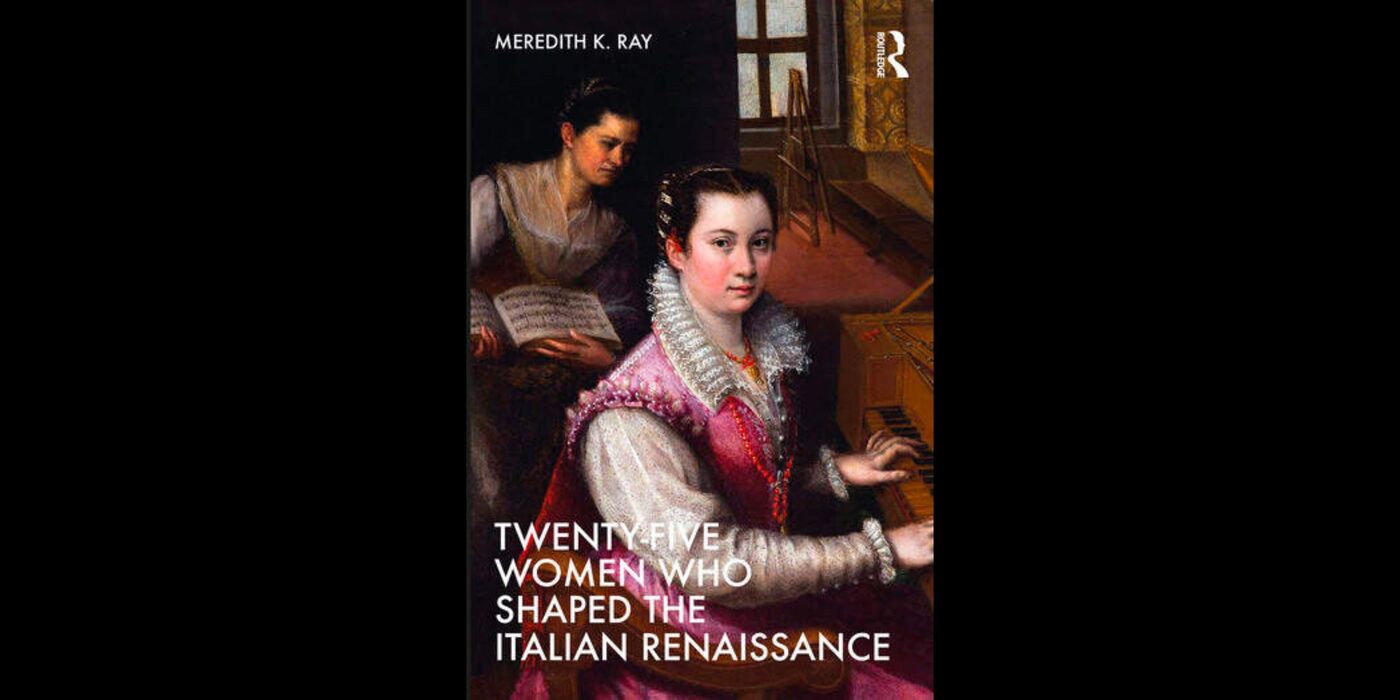Why bother with all the history books, when their authors–being men who are envious of women’s worthy deeds–do not talk about women’s noble actions, but instead consign them to silence?
– Lucrezia Marinella, 1601
“Renaissance Italy”: the words evoke figures like Botticelli, Raphael, and Leonardo; Michelangelo, Machiavelli, and Monteverdi. These are the one-named “giants” we have come to associate with the Renaissance, the era that produced some of history’s best-known works of art, literature, and music. Maybe we think of Petrarch, the great scholar and poet who mined the human psyche in his love lyric, or Galileo, the astronomer who jolted the earth from its position at the center of the cosmos. The Renaissance was an epoch of seismic shifts in art and culture, science and religion, politics and philosophy–in how people thought about the world and their place in it.

But what about the women of the Renaissance? Lorenzo “the Magnificent,” the de facto prince of Florence, is credited with presiding over one of the most significant cultural centers of the fifteenth century–but his mother, Lucrezia Tornabuoni, was a poet and political force in her own right. The inspired verse of the “divine” Vittoria Colonna of Naples–the first woman to have a book of poetry published in Italy–made her one of the most famous figures of the age, her name synonymous with literary excellence. Friend and spiritual mentor to Michelangelo, she was immersed in the new religious currents that reverberated throughout Italy as the Protestant Reformation unfolded to the north. Lavinia Fontana painted vivid, complex portraits and large scale religious, historical, and mythological paintings; by the time she died, she rivaled Caravaggio as the most famous artist in Rome. In seventeenth-century Venice, the Benedictine nun Arcangela Tarabotti penned fierce condemnations of the oppression of women–and published them–a shockingly subversive act given her cloistered religious status. These women’s names–and so many more–often go unrecognized in narratives of the Renaissance that reflexively privilege male genius. How can we recover these hidden histories? And why does it matter?

Centuries after the Renaissance, gender equality remains elusive. In many parts of the world, girls and women have access to education and healthcare, legal protections, self-determination, and financial stability–but there are significant gaps in, as well as retreats from, that progress. Women exert greater control and choice over their lives and career paths than they did in the Renaissance–but autonomy over their bodies remains in question, or actively denied. The wage disparity persists. Many countries, including the United States, have yet to elect a female head of state, and ideas about politics and gender are deeply fraught. As we continue working toward gender parity in the present and the future, we must also re-center women in our narratives of the past. This means writing women into history–intentionally, deliberately, and thoughtfully. It means shifting the lens through which we view the past, asking different questions, and valorizing a wider range of political and creative activity. When we see women represented in history–and when women see themselves there–it alerts us to their collective impact in shaping our world in profound, important ways. Rich, exciting conversations were happening all over Renaissance Italy, and women were a part of them. Why aren’t we more aware of their presence?

This is not a new question: Renaissance writers were already considering it. In the mid-fourteenth century, Giovanni Boccaccio intertwined biographies of noted women from history and legend in his widely circulated De claris mulieribus (Concerning Famous Women). Though he highlighted their stories, Boccaccio saw his protagonists as exceptions to the (male) rule, musing, rhetorically, “what can we think except that it was an error of nature to give female sex to a body . . . endowed by God with a magnificent virile spirit?” A half century later, Christine de Pizan, writing in France, composed Le Livre de la Cité des Dames (The Book of the City of Ladies) in response to a flood of misogynistic literature (so blatant that it prompted her to “examine myself and my condition as a woman”), sparking a querelle des femmes, or “debate over women,” throughout Europe that compelled writers and philosophers to either defend or defame them. The debate about women’s capabilities and “proper” roles was ongoing in the sixteenth century when Lodovico Ariosto, the Italian author of a beloved chivalric tale of knights and adventures populated by strong female characters, paused mid-poem to comment on historiography. “Women have achieved in every art/and craft the highest distinction,” he observed–so why are their achievements “concealed”? Ariosto posited that envy or ignorance was to blame, going on to praise a host of female contemporaries by way of recompense. History’s inclination to gloss over or elide entirely the contributions of women, while highlighting and preserving those of men, had clearly not been resolved.

Renaissance women wrote about the same problem. In her own chivalric poem, the sixteenth-century Venetian writer Moderata Fonte picked up where Ariosto left off, insisting that women are “endowed by Nature with excellent judgement and great courage, and they are born no less well fitted than men to display wisdom and valor, if properly trained and nurtured.” If they are provided the same opportunities as men, she noted–making a comparison to the mining of gold from unrefined ore–their worth will be revealed, for gold has innate potential, even before it is extracted and polished. Her compatriot Lucrezia Marinella amplified the point and made an even clearer recommendation. Women are excluded from education, she argued, because “men, fearing to lose their authority and become women’s servants, often forbid them even to learn to read or write.” Therefore, she asserted, it is essential for women to keep their own record–in essence, to create the discipline of women’s history–because “history books” have been authored by men to their own advantage. The Neapolitan poet Laura Terracina likewise exhorted women to “dedicate ourselves to learning,/and make space for our neglected voices,/so they are not so quiet/that they cannot be heard above the writings of men.” As each of these authors recognized, gender equality first requires visibility.
If the accomplishments of a handful of accomplished Renaissance women were recognized even in their own time, how can we recapture the many more who have been relegated to undeserved obscurity? Over the past decades, feminist historians have led the way in asking important questions about women’s roles in family, religion, culture, and politics. Retracing the steps of Renaissance women can require some detective work: combing libraries for rare books or manuscripts, following the trail of an obscure footnote to discover the woman at its center, or paying attention to silences in the archives–to what is absent from the historical record as well as what is preserved.

I began my own search as a graduate student: while I loved the classics of the Italian literary canon, female names were noticeably absent from many of my reading lists. I was lucky to be able to learn from my own professors and other scholars working in the developing field of women and gender studies, and to glimpse what might be missing. It was a revelation: Renaissance women did things. I kept reading. I went to Italy and continued the quest. In the libraries of Florence and Venice–with their gorgeous reading rooms, lined with centuries-old volumes–and in archives from Milan to Rome, the most rewarding research moments came hidden within centuries-old buste of fragile, fading documents. Seeing the handwriting of a Renaissance woman whose story you have been trying to uncover–on a letter, a contract, or a will–or her name on an elaborate sixteenth-century title page can spark a strong and unexpected sense of connection to the past, as well as awareness of the many differences owed to time, geography, and circumstance. (Sometimes, there are other surprises, too, like the remains of a sixteenth-century scorpion preserved among the papers of a Venetian convent.) To write women’s history requires searching in unexpected places–and to read it helps us to create a more expansive view of the past.
From: Twenty-Five Women Who Shaped the Italian Renaissance by Meredith K. Ray (Routledge, 2023). Reproduced by permission of Taylor & Francis Group.

A note from the author:
Reconstructing the lives of women in history is inevitably a selective, subjective, and fragmentary undertaking. In Twenty-Five Women Who Shaped the Italian Renaissance, I have focused on figures whose lives can be amply reconstructed from historical accounts, writings, and records, incorporating some who may be less familiar to readers (like Lucrezia Gonzaga, a writer and religious reformer who survived an abusive marriage, or the sixteenth-century poet and virtuosa Tarquinia Molza); or highlighting less well-studied aspects of better-known figures, like Isabella d’Este, Caterina Sforza, and Lucrezia Borgia. But there are many more stories yet to be told–especially those of the “invisible women” who are so often absent from the historical record: working women, servants, enslaved and manumitted women. That’s why I’m excited to be directing a new Routledge book series called "Twenty-Five Women Who Shaped….,” which will cover a wide range of women’s history: globally, chronologically, thematically. The Italian Renaissance is only the beginning (and p.s.—we are seeking proposals!).
And that’s why The New Historia is so crucial to the next frontier in restoring women to history. Founded by Gina Luria Walker to launch a "revolution in knowing about women,” it is ambitious in scope yet easily searchable by name, keyword, or thematic “patterns.” The New Historia allows us to dig into the connections—as well as differences—between women across time, cultures, areas of activity, and geography. By combining individual stories within a framework that allows us to see the collective—and by fostering collaboration among scholars from many different areas—we can continue to make the female past visible.
Meredith K. Ray is the Elias Ahuja Professor of Italian at the University of Delaware, with a joint appointment in Women & Gender Studies. Her books include Writing Gender in Women’s Letter Collections of the Italian Renaissance (2009); Daughters of Alchemy: Women and Scientific Culture in Early Modern Italy (2015); and Margherita Sarrocchi’s Letters to Galileo: Astronomy, Astrology, and Poetics in Seventeenth-Century Italy (2016). With Lynn Lara Westwater, she has edited and translated several works by the 17th-century Venetian nun and early feminist Arcangela Tarabotti. Her research has been supported by the Rockefeller Foundation, the National Endowment for the Humanities, the Gladys Krieble Delmas Foundation, and others. A past president of the Society for the Study of Early Modern Women & Gender, she is co-editor of the series The Early Modern Exchange (University of Delaware Press) and General Editor of the series Twenty-Five Women Who Shaped… (Routledge). You can contact her at mkray@udel.edu or find her on Instagram @meredith_k_ray.


